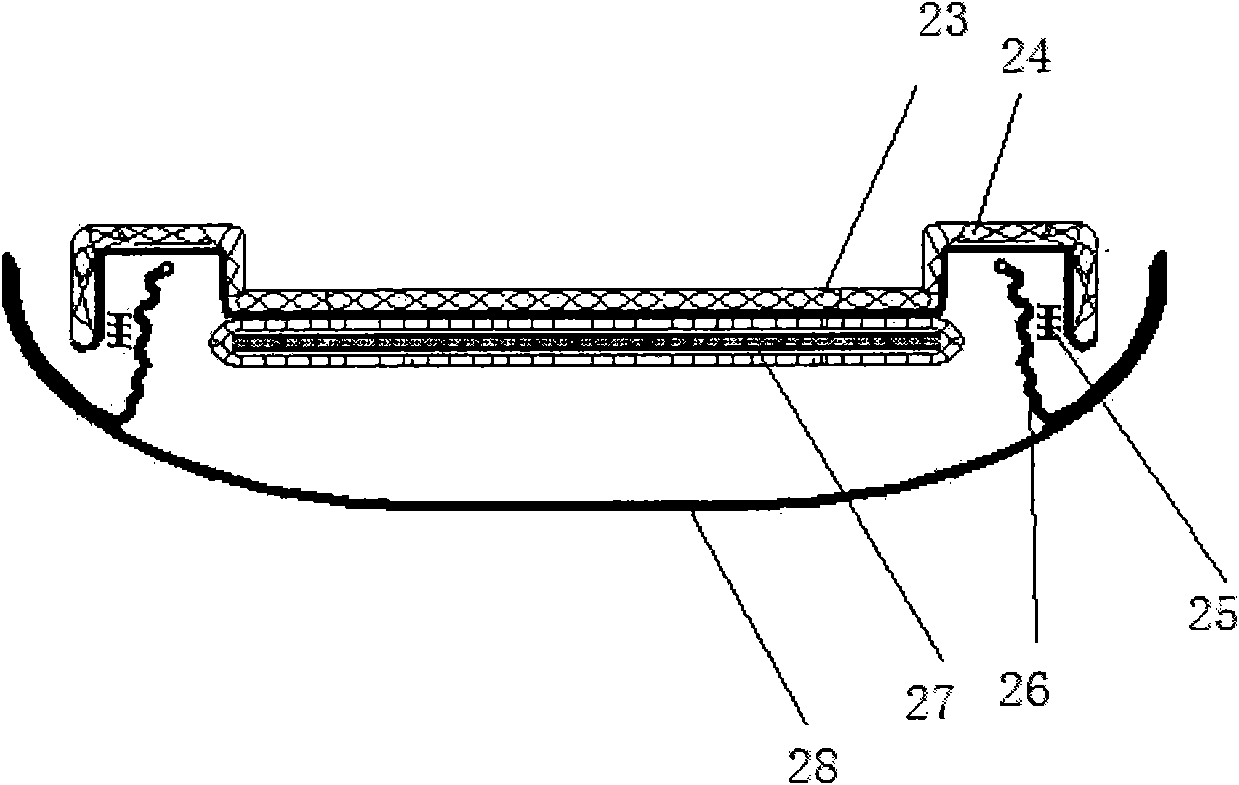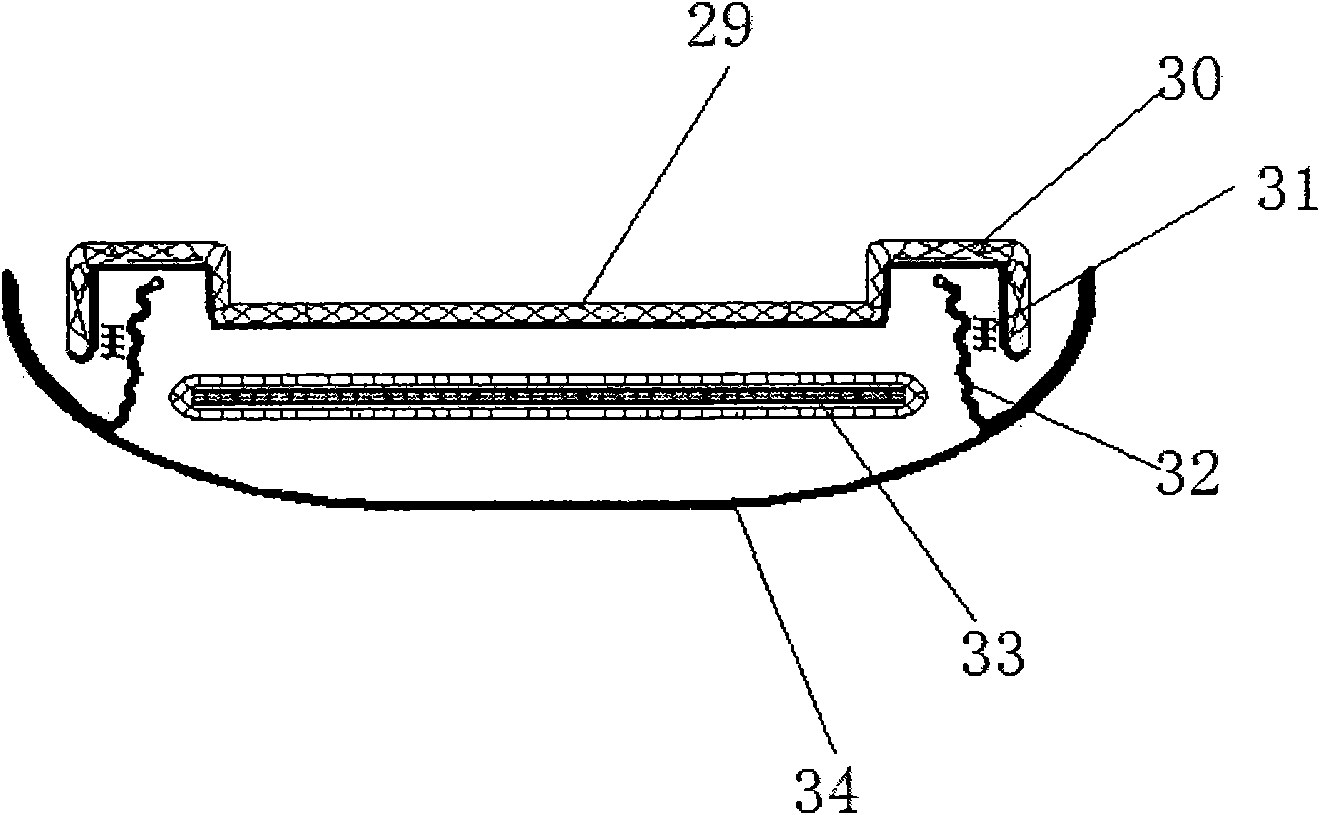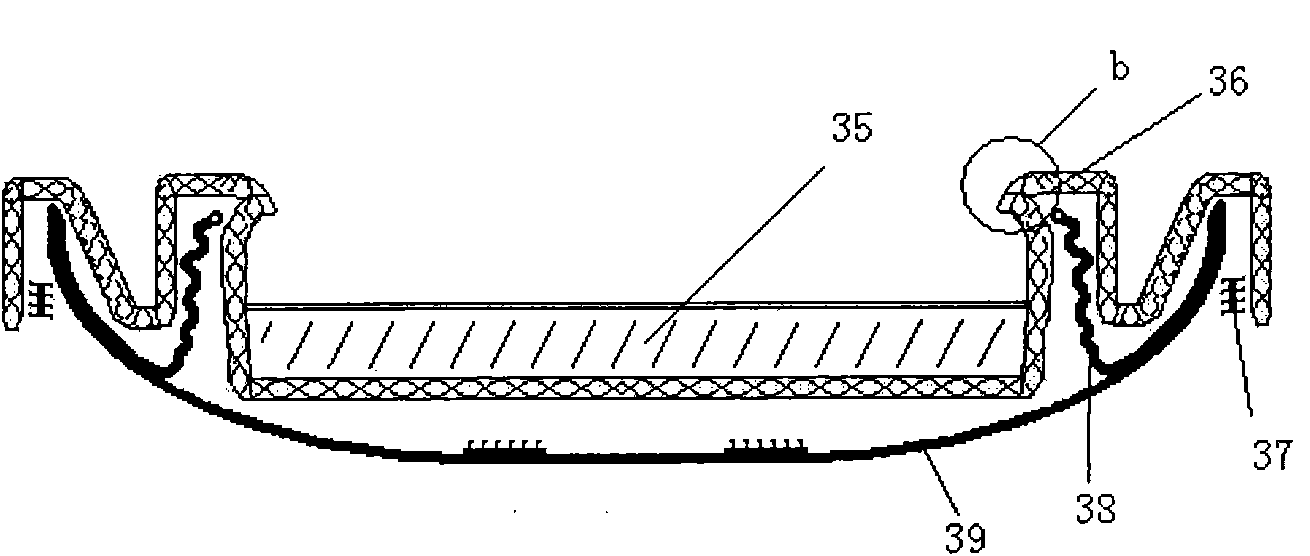Although this structure can realize the effect of multiple cleanings, the inner side of the trouser cover is not provided with side wings, so the leakage resistance is poor and it is easy to move; but if there are side wings, the trouser cover will be polluted by
feces after use. It will bring more inconvenience for cleaning the trouser cover, so that the multiple utilization of the trouser cover cannot be realized, so this structure still has the following defects: the functions of leak prevention and multiple utilization cannot be realized at the same time, that is, it cannot be used in the protection of the flanks. Keep the pants and pants from
contamination while allowing the pants to be reused many times
[0008] (1) Cannot be used multiple times: the existing sanitary products, the separation layer, the absorbent layer and the leak-proof layer are tightly joined together, the entire product structure is a complete and bonded whole, and the absorbent layer is made of cotton , pure wood
paddle (
wool paddle) or
super absorbent polymer powder are all
powder-like substances in structure, so the separation layer,
absorption layer and leak-proof layer cannot be separated. After the excrement, it needs to be packed in time and discarded at a long distance. The discarded sanitary products cannot be washed and reused, and can only be used as one-time use. When the sanitary products only accept the wearer's
urine, if the wet sanitary products After the separation layer and the leak-proof layer are cleaned and dried, they are still hygienic and can be used many times, but discarding them will cause serious waste and the economy is very poor; at the same time, sanitary products contain a variety of material components that are not easy to decompose , waste sanitary products cannot be economically recycled, processed and reused, causing serious environmental
pollution[0009] (2) Uneconomical: The hygienic products of the prior art, such as diapers with Velcro, elastic
waist, bulky cotton
fiber backing or three-dimensional protection, are more perfect and practical hygienic products, although they are more comfortable during use. products, but its materials are complex, the
workmanship is complicated, and the cost is also expensive; and observations have found that for diapers, the trouser body only accepts the wearer's
urine, if the wet
fiber cotton surface and trouser lining are cleaned and dried Afterwards, the leak-proof layer (bottom liner) of the sanitary product is still hygienic, brand new and strong, and can be used many times. However, since the whole sanitary product is inseparable, it cannot be washed and reused. All material components of the diaper are only used as One-time use, poor economy, serious waste
[0010] (3) Not
environmentally friendly: After the existing diapers or sanitary napkins have received excrement, the trousers or towel body needs to be packaged and discarded, and the trousers or towel body contains a variety of material components that are not easy to decompose, especially the leak-proof layer ( or
plastic film bottom liner) is the most difficult to decompose, and its main component is plastic products made of
polyethylene materials extracted from
petroleum. The phenomenon of serious environmental
pollution causes serious "white
pollution"; while the leak-proof layer (or
plastic film bottom liner) of existing sanitary products generally adopts PE material, PE (scientific name
polyethylene) is
ethylene through addition
polymerization A
thermoplastic resin prepared by reaction, according to different
polymerization conditions,
polyethylene with a relative molecular weight
ranging from 10,000 to several million can be obtained
[0011] (4) The functions of leak-proof and multiple utilization cannot be realized at the same time: in the existing diapers, there is also a trouser cover that can be cleaned many times, that is, a sheet-shaped diaper is placed in the trouser cover before use, and combined to form a diaper. One pair of trousers
Although this structure can realize the effect of multiple cleanings, the inner side of the trouser cover is not provided with side wings, so the leakage resistance is poor and it is easy to move; but if there are side wings, the trouser cover will be polluted by
feces after use. It will bring more inconvenience for cleaning the trouser cover, so that the multiple utilization of the trouser cover cannot be realized, so this structure still has the following defects: it cannot realize the functions of leak prevention and multiple utilization at the same time, that is, it cannot protect both the flanks and the The pant cover is protected from pollution while allowing the pant cover to be reused multiple times
[0012] (5) Poor air permeability: Since the anti-leakage layer placed at the bottom is made of
plastic film, PE film or PE film combined with non-
woven fabric and other materials, the plastic film has no air-permeable micropores (holes that are not easy to see with the
naked eye), while the PE film And non-woven fabrics have only micropores. Although they can prevent the leakage of liquids and other substances, their air permeability is very weak. The micropores are blocked, so that the ventilation effect is not optimistic. The heat generated in the user's body during use cannot be quickly circulated and dissipated, resulting in a humid and hot environment inside the
hygiene product. In the harsh environment, the
bacteria and harmful substances excreted by the
human body are easy to multiply and grow quickly. The
delicate skin of women needs a very breathable environment. If it is sealed too tightly and
moisture accumulates, germs will
breed and cause various
health problems. More leucorrhea, yellowish color or bloody
odor, etc., and
pose certain harm to the body
[0013] (6) Poor observation effect: Since there are only micropores or even no holes on the leak-proof layer at the bottom, and the transparency of the materials generally used is poor, it is impossible to observe the color change or the degree of color change of the absorbent layer from the bottom of the hygienic product. Just can't more accurately determine whether the absorbing layer is saturated, thereby judge whether need to replace new sanitary product; It cannot be used safely and conveniently by some special groups who have special requirements or are weak and are extremely susceptible to gynecological diseases, such as some puerpera, those who have just completed
gynecological surgery and those who are involved in gynecological problems.
[0014] (7) Severe seepage phenomenon: when the
absorption capacity of the absorbent layer exceeds saturation, if the user does not replace it in time, the liquid in a
free state will seep back to the contact surface between the
human body and the separation layer, and in the contact surface between the human body and the separation layer. The rapid proliferation of the contact surface will cause discomfort and allergies to the wearer, and even cause gynecological
inflammation, which will cause harm to
human health; although in the prior art, sanitary products equipped with color-changing display agents, when the absorber of the absorbent layer is saturated, overflow The liquid in contact with the discoloration display agent, after the discoloration display agent contacts
moisture, physical reaction changes the color, and the
nursing staff can replace the hygienic article after observing the saturation discoloration of the discoloration display agent of the bottom liner, but the hygienic products of the prior art The premise of the discoloration principle of the product is that there must be excess liquid in contact with the color-changing display agent. When the excess overflowing liquid is in contact with the discoloration display agent, it may also seep back from the cotton surface or mesh surface of the separation layer. The seeping liquid will infect and entrain a large number of
bacteria and harmful substances from the absorbent layer, and the sanitary products absorb liquid excretions such as urine, sweat,
menstrual fluid,
menstrual blood and
vaginal discharge during use, and these liquids are excreted A variety of compounds are formed in the absorbent layer of clothing at a certain stage of wearing. These compounds include fatty acids,
ammonia, amines,
sulfur compounds, ketones and aldehydes. According to research, there are 9-108 microorganisms per
gram of
menstrual blood.
Menstrual blood is a very good breeding ground for
bacteria and other microorganisms.
Bacteria are easy to
breed. If sanitary products are not replaced in time, the harmful liquid that seeps back may enter the
endometrium along the
vagina and infect many tiny wounds and ruptured small blood vessels in the
endometrium. A large number of bacteria and harmful substances will infect the
endometrium, and even affect the fallopian tubes and
pelvic organs, thus posing a
threat to
human healthHowever, the existing hygienic products cannot visually prompt the caregiver whether the
user needs to replace the hygienic product. Although the hygienic product provided with the urine wetness discoloration display agent can visually prompt the replacement, the back seepage phenomenon is serious and the air permeability is poor. None of the existing sanitary products can meet the needs of such special groups of people, because for these special groups of people, the sanitary napkins they need should not only have better air permeability, but also prevent the formation of
damp heat inside the sanitary products, which is easy to cause bacteria In the harsh environment where rapid growth occurs, and the liquid cannot be reversed, it should be able to visually prompt the caregiver from the leak-proof layer whether the sanitary product needs to be replaced, so as to avoid the caregiver's
confusion when the sanitary product is uncovered or taken off. Interfering with the patient's rest during the procedure
[0016] Due to the above defects in the existing hygienic products, they can no longer meet the needs of people's lives and the requirements of
environmental protection.
 Login to View More
Login to View More  Login to View More
Login to View More 


